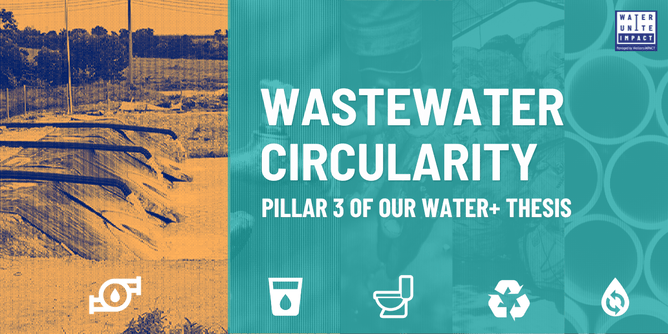Wastewater presents a potentially untapped resource that, through treatment, can provide numerous direct benefits from its components, such as energy production via biogas and nutrient recovery. Stewarding this resource properly not only mitigates environmental pollution but also reduces water withdrawals, aligning with circular economy principles, and decreases instances of waterborne diseases. However, only 52% of global wastewater is treated, with a huge disparity between high income (74% avg.) and low income (4.3% avg.) countries (United Nations University 2020).
There are two key aspects to wastewater processing that need to be addressed. The first is the growing population and consequently the increased amount of wastewater produced. The second is improving the effectiveness of wastewater treatment, by shifting the focus to “what can be recovered” and what value can be added to something we have long considered a waste product, rather than “what we can remove” in terms of mitigating damage.
Capacity and Funding for Wastewater Treatment
Overall the WASH sector is failing to meet its specific targets. Only 36% of appeals for water and sanitation related funding were met in 2023, leaving a 64% gap (Action Against Hunger 2024). While there is a growing trend of wastewater management investments being included in “Blue Finance” portfolios and strategies (Nobel 2024), there is still much to be done to build current utility capacities and innovate current infrastructure to keep up with a growing population and climate risks.
While traditional investment structures may fall short in bridging the funding gap for wastewater treatment, bringing together various financial entities and key stakeholders through innovative blended finance models offers a promising solution. Senior capital from high-net-worth individuals (HNWIs), development finance institutions (DFIs), and other financial institutions can be united and leveraged alongside corporates and trade partners.
Clearly, our growing population will increase demand for resources, products, and services across all sectors. In particular an increased population will produce more wastewater, increasing demand on municipalities and utilities. Without the proper infrastructure and innovative solutions, this could overwhelm existing systems, leading to untreated or poorly treated wastewater being released into the environment, with severe consequences for public health and ecosystems.
Pillar 3 of our Water+ investment thesis advocates for the promotion of wastewater circularity. Instead of viewing wastewater as a growing burden, we should see it as an expanding opportunity and a resource that can help meet the increasing demand for energy, water, and nutrients.
Pollution Removal & Green Energy Production in Wastewater Treatment
River pollution from untreated wastewater is a significant issue that must be addressed in a holistic manner, considering its carbon footprint, agricultural effects, and biodiversity impact. One of the most promising aspects of wastewater treatment is its potential to simultaneously reduce pollution and contribute to green energy production.
The organic matter in wastewater is a rich source of energy that can be harnessed through anaerobic digestion, a process that breaks down organic materials in the absence of oxygen to produce biogas—a mixture primarily composed of methane and carbon dioxide. This is a particularly useful energy source in regions where access to electricity is unpredictable and inconsistent..
Turning the negative output (organic matter in untreated wastewater) into a positive output (a biogas energy product) will not only provide a useful energy source, but the process of separating and treating the water to create this product will reduce river pollution and prevent harmful organic and inorganic matter circulating through agricultural ecosystems, affecting crop quality and yield.
This also helps to prevent contamination and spread of the disease across ecosystem interactions. This is important to consider as river pollution in rural villages may not be measured which would have significant consequences for residing human populations who may use the local rivers for personal purposes. Its treatment would indirectly contribute significantly to reducing waterborne diseases, even if this is not the primary aim. Building water stewardship capacities in these regions is vital for filling in missing data gaps on river pollution - you can’t manage what you can’t measure.
Gree Energy & Wastewater Circularity
Gree Energy’s projects go far beyond immediate waste reduction and energy production. By implementing sustainable wastewater management solutions, Gree Energy plays a crucial role in reducing greenhouse gas emissions, mitigating pollution, lowering the risk of waterborne diseases, and promoting renewable energy use in the communities where it operates.
Based in Indonesia, Gree Energy collaborates with local food processors to maximise its environmental impact. Their innovative technology is capable of treating up to 99% of the pollution generated by these food processors, addressing a significant source of contamination in the region. Gree Energy’s research has shown that local food processing industries are a major contributor to water pollution, posing serious risks to ecosystems and public health.
In addition to producing valuable biogas—a critical energy resource for areas with limited electricity—Gree Energy plays a pivotal role in reducing pollution in Indonesia’s highly contaminated rivers. By turning wastewater into a renewable energy source, the company not only addresses the region’s pollution challenges but also delivers a practical and sustainable end-product that benefits both the environment and local communities.
Bibliography
Action Against Hunger (2024) 2024 Water Funding Gap Report. Available at: https://www.actionagainsthunger.org.uk/publications-and-reports/2024-water-funding-gap-report#:~:text=Our%20analysis%20shows%20that%20globally,%2C%20leaving%20a%2064%25%20gap.&text=Unsafe%20water%20and%20sanitation%20contribute,particularly%20susceptible%20to%20waterborne%20diseases.
Nobel, A. (2024) Blue Finance: Closing the water financing gap, Rabobank. Available at: https://www.rabobank.com/knowledge/d011423183-blue-finance-closing-the-water-financing-gap.
United Nations University, (2020). Global wastewater status Available at: https://unu.edu/inweh/tools-and-resources/global-wastewater-status

